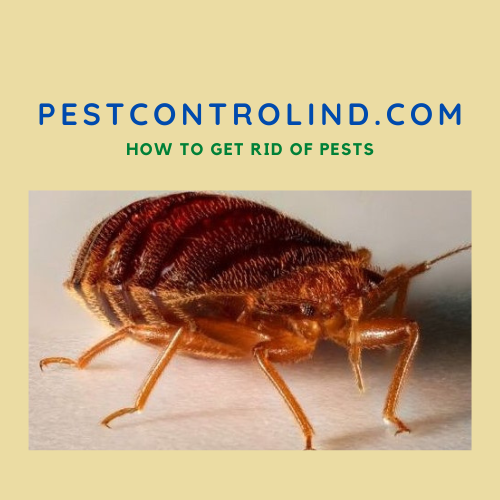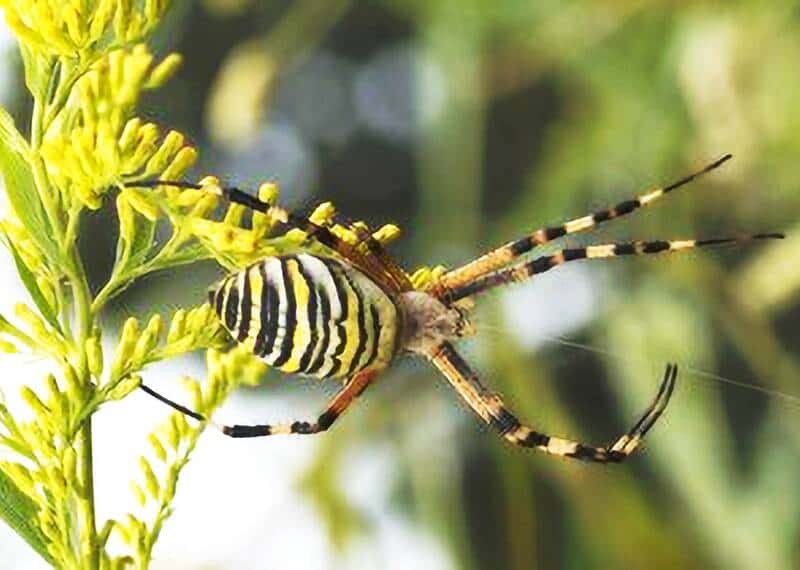Is black and yellow garden spider poisonous? What is the life cycle of the Argiope hornet spider? What does it eat?
Here are the answers to all these questions, as well as other useful information on the Argiope, the yellow and black spider.
I. Description of the Argiope spider
The Argiope is often referred to as the wasp spider or the black and yellow garden spider. As with many spider species, the females of this species reach a much larger size than the males.
The body length of adult females varies from 19 to 28 mm, while males reach only 5 to 9 mm.
In both sexes, the shiny egg-shaped abdomen has striking yellow or orange markings on a black background.
The front part of the body, the cephalothorax, is covered with short, silvery hairs. The legs are mainly black, with red or yellow parts near the body.
This species has three claws per foot, one more than most spiders. This third claw helps it manipulate threads during spinning.
The Argiope has a venomous bite that immobilizes its prey when caught in its web.
I. Is the black and yellow garden spider poisonous?
Like almost all other spiders, the Argiope spider is harmless to humans.
As with most garden spiders, they eat insects and are capable of consuming prey up to twice their size.
They can potentially bite if seized, but apart from defense, they do not attack large animals.
Their venom is not considered a serious medical problem for humans; it often contains a wide variety of polyamine toxins that can be used as therapeutic agents.
A bite from the black and yellow garden spider (Argiope aurantia) is comparable to a bee sting, with redness and swelling.
For a healthy adult, a bite is not considered a problem.
Although they are not aggressive spiders, toddlers, the elderly, and those with fragile immune systems, or known venom allergies, should exercise caution when dealing with these spiders.
# Is it safe to pick up a yellow garden spider?
As we have just pointed out, they are essentially harmless to humans.
Scientific findings confirm that the venom of yellow garden spiders is not potent enough to pose a substantial threat to human health.
Consequently, collecting these eight-legged creatures, while not recommended due to the potential stress caused by spiders, presents no inherent risk to human safety.
However, it is prudent to bear in mind that a bite, although unlikely, can cause discomfort. The resulting symptoms – localized pain, redness and swelling – are generally mild and transient.
Caution is therefore advised when considering the physical handling of a yellow garden spider.
# Are yellow garden spiders poisonous to dogs?
Of course, we can’t deny that yellow garden spiders, like most arachnids, possess venom.
They use it mainly to subdue their prey, which is considerably smaller than our canine companions.
Mainly, scientific studies have revealed that this venom poses no significant threat to dogs.
Ergo, even in the unlikely event of a bite, it generally doesn’t cause panic.
But, of course, discretion is key. Dogs, however curious, can provoke these spiders, resulting in a potential bite.
Although not fatal, the bite can cause localized symptoms such as redness, swelling and mild discomfort in your pet, which usually disappear without intervention.
So it’s a prudent approach to prevent dogs from snooping around the webs of these spiders or trying to play with them.
III. Life cycle and biology
In temperate climates, the vast majority of species live for just over a year: from hatching in autumn to the first hard frost the following year.
However, in warmer climates and captivity, females of this species can live for several years.
Males probably die after mating in their first year.
Adult males wander around looking for potential mates. Once they find a female, they build small webs nearby and court her.
When it’s time to mate, the male threads a companion web next to the female. After mating, the female lays her eggs and places her egg sac in the web.
The egg sac contains between 400 and 1400 eggs. The egg sac is composed of several layers of silk and protects its contents from damage.
In regions with harsh winters, the eggs of this species hatch in late summer or autumn.
However, the newborn spiders are in hibernation and don’t leave the egg sac until the following spring.
Newborns generally resemble small adults. There are therefore no major changes in anatomy or structure as they grow, except for the development of reproductive organs.
IV. What they eat and how they hunt
Like all spiders, black and yellow Argiopes are carnivores. They spin an orb web to capture small flying insects such as aphids, flies, grasshoppers, and Hymenoptera (wasps and bees).
A female can take prey up to 47 mm in diameter, 200% larger than her size.
Given the right climate, Argiope spiders can be active day and night, attacking insects trapped in their webs.
They often build and repair their webs after dark, but can also do so during the day.
Once they find suitable sites for their webs, they tend to stay there unless the web is frequently disturbed, or they can’t catch enough food.
The web can be up to 70 cm in diameter. The spider hangs, head down, in the center of the web, waiting for its prey.
Often, it holds its legs together in pairs, so that there appear to be only four of them.
Sometimes, the spider may hide in a nearby leaf or grass stalk, connected to the center of the web by a non-sticky thread that quivers when prey lands on the web.
V. Why the female eats the male after copulation?
Although rarely observed, female Argiope in some cases eats the male immediately after copulation.
As already mentioned, male silver Argiopes are short-lived. Once mature, they will mate but once or twice before dying.
Usually, males that manage to reproduce and not fall prey to their partners, die spontaneously during or immediately after their second mating.
Although it seems that the male is somewhat extensible in this equation, his sacrifice is crucial to ensure the transmission of his genes.
This is because, during mating, parts of his copulatory organs fall into place, acting as a kind of plug to prevent potential future suitors from mating with the same female.
If the plug works and fertilization is successful, her offspring will also benefit from her nutritional contribution to their mother, who will soon look after the eggs and protect the clutch until the spiders are ready to leave the web.
Useful Links:
YELLOW GARDEN SPIDER, WRITING SPIDER ARGIOPE AURANTIA (LUCAS) (ARACHNIDA: ARANEAE: ARANEIDAE)

